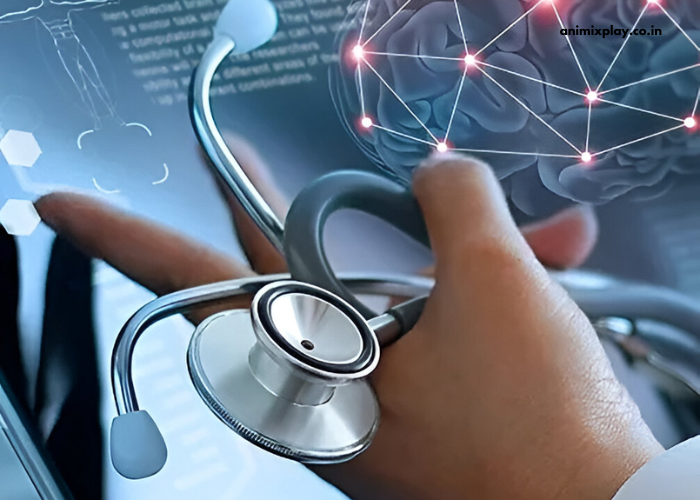The healthcare industry is undergoing a significant transformation, driven largely by technological advancements. From artificial intelligence (AI) to telemedicine, new technologies are reshaping the way healthcare is delivered, improving patient outcomes, and enhancing operational efficiencies. In this article, we will explore how technology is advancing healthcare solutions, with a focus on key innovations that are revolutionizing the sector. Whether it’s through enhanced diagnostics, more personalized treatments, or improved patient care, technology is paving the way for a brighter future in healthcare.
Artificial Intelligence and Machine Learning in Healthcare
Artificial intelligence (AI) and machine learning (ML) are two of the most prominent technological advancements in the healthcare industry today. These technologies enable healthcare providers to analyze vast amounts of data to make more accurate diagnoses, predict patient outcomes, and personalize treatment plans.
AI-Powered Diagnostics
AI algorithms can analyze medical images, such as X-rays, MRIs, and CT scans, with remarkable accuracy. For example, AI has demonstrated its ability to detect early signs of conditions like cancer, heart disease, and neurological disorders, often more accurately than human doctors. This allows for earlier intervention, which is critical for improving patient survival rates and outcomes.
One of the leading examples of AI in healthcare is IBM Watson Health, which uses natural language processing (NLP) and machine learning algorithms to sift through medical literature, patient records, and clinical trial data. This helps clinicians make evidence-based decisions that are tailored to individual patient needs.
Predictive Analytics for Patient Outcomes
Machine learning models are being used to predict patient outcomes based on historical data and real-time information. These predictions can inform healthcare providers about potential complications before they arise, allowing them to take preventive measures. For instance, hospitals use predictive analytics to forecast which patients might develop infections after surgery, so they can take steps to reduce the risk.
AI in Personalized Medicine
AI and ML are also playing a crucial role in personalized medicine, which tailors medical treatments to the individual characteristics of each patient. By analyzing genetic data, lifestyle factors, and medical history, AI systems can help physicians create customized treatment plans. This approach is particularly useful in fields like oncology, where different patients may respond to treatments in very different ways.
Telemedicine and Remote Patient Monitoring
Telemedicine has become increasingly popular in recent years, especially during the COVID-19 pandemic, which highlighted the need for remote healthcare solutions. Telemedicine allows patients to consult healthcare providers from the comfort of their own homes, reducing the need for in-person visits and making healthcare more accessible, especially for those in rural or underserved areas.
Virtual Consultations
Through video conferencing, patients can consult with doctors, specialists, or other healthcare professionals without the need for physical visits. This has proven to be particularly useful in non-emergency situations, such as routine check-ups, follow-up consultations, and mental health therapy sessions.
Telemedicine also enables healthcare professionals to reach a broader patient population, overcoming geographical barriers and providing access to high-quality care in remote regions.
Remote Patient Monitoring
In addition to virtual consultations, remote patient monitoring (RPM) allows healthcare providers to track patients’ health metrics in real-time. Wearable devices, such as smartwatches, fitness trackers, and specialized medical gadgets, collect data like heart rate, blood pressure, glucose levels, and oxygen saturation. This data is transmitted to healthcare providers who can monitor the patient’s condition and intervene if necessary.
RPM is especially beneficial for chronic disease management, as it allows doctors to monitor patients’ conditions continuously and adjust treatments accordingly. For example, patients with diabetes can use glucose monitors that send real-time data to their doctors, enabling more timely adjustments to their treatment plans.
Blockchain in Healthcare Data Security
As healthcare becomes increasingly digitized, ensuring the security of sensitive patient data is a top priority. Blockchain technology, known for its secure, decentralized nature, is being explored as a solution to safeguard healthcare data from breaches, fraud, and unauthorized access.
Secure Health Records
Blockchain allows for the creation of immutable, encrypted digital records that are securely shared between authorized parties. This ensures that patient data is protected from tampering, and it gives patients greater control over their own health information. Blockchain also enables healthcare providers to access a comprehensive and up-to-date record of a patient’s medical history, reducing the chances of errors or duplication.
Transparent Supply Chains
Blockchain technology can also improve transparency in healthcare supply chains, ensuring that medical products and pharmaceuticals are sourced ethically and are of the highest quality. By tracking the movement of drugs and medical equipment through the supply chain, blockchain reduces the risk of counterfeit products, which is a growing concern in the healthcare sector.
Robotics in Surgery and Patient Care
Robotics has long been used in the manufacturing and automotive industries, but its application in healthcare is becoming increasingly widespread. Robotic surgery, in particular, has transformed the way complex procedures are performed, offering patients less invasive options and faster recovery times.
Minimally Invasive Surgery
Robotic-assisted surgery allows surgeons to perform procedures with greater precision, often through smaller incisions. This results in less trauma to the body, reduced pain, and shorter recovery times for patients. One of the most notable examples of robotic surgery is the da Vinci Surgical System, which allows surgeons to perform complex surgeries, such as prostatectomies and heart bypass surgeries, with enhanced precision and control.
Robots in Elderly Care
Robotic technology is also being used to assist with elderly care, particularly in home care settings. Robots can help seniors with daily activities such as dressing, walking, and taking medication. In some cases, robots equipped with AI are being used to monitor the well-being of elderly patients, providing real-time alerts to caregivers if a patient experiences a fall or other health emergency.
3D Printing for Personalized Healthcare Solutions
3D printing technology is being increasingly utilized in healthcare to create personalized medical devices, implants, and even prosthetics. This technology allows for the production of custom-made products that are tailored to an individual’s anatomy, improving both the effectiveness and comfort of the healthcare solutions.
Custom Prosthetics and Implants
One of the most significant uses of 3D printing in healthcare is the creation of prosthetics. Traditional prosthetics can be costly and uncomfortable, but 3D printing allows for the creation of more affordable, lightweight, and comfortable prosthetic limbs. Moreover, these prosthetics can be customized to fit the exact measurements of the patient’s body, ensuring a more personalized and functional solution.
3D printing is also used to produce implants, such as dental implants or joint replacements, that are custom-designed to fit a patient’s unique body structure. This can result in fewer complications, faster recovery times, and improved outcomes.
Bioprinting and Tissue Engineering
Bioprinting, a subset of 3D printing, involves printing human tissues and organs using bio-inks made from living cells. While this technology is still in its early stages, researchers are optimistic that bioprinting could one day revolutionize organ transplants by allowing for the creation of custom organs that are less likely to be rejected by the recipient’s immune system.
Virtual Reality and Augmented Reality in Healthcare Training and Therapy
Virtual reality (VR) and augmented reality (AR) are making waves in healthcare, especially in the areas of medical training and patient therapy.
Medical Training and Simulations
VR and AR are being used to create immersive training environments for medical students and professionals. With VR, students can perform virtual surgeries, interact with 3D models of human anatomy, and simulate real-life medical scenarios, all without the risk associated with practicing on actual patients. This provides invaluable hands-on experience and improves the learning process.
Therapeutic Applications
In addition to medical training, VR and AR are also being used in patient therapy. For example, VR is used in pain management, offering patients immersive environments that can distract them from chronic pain or anxiety. AR, on the other hand, is being used in rehabilitation programs, where patients can interact with virtual environments that assist with physical therapy exercises.
Conclusion: A New Era of Healthcare
Technology is revolutionizing the healthcare industry in profound ways. From AI and telemedicine to robotics, 3D printing, and blockchain, these advancements are improving the accuracy of diagnoses, enhancing the quality of patient care, and reducing costs. As technology continues to evolve, the potential for further innovation in healthcare is boundless. The future promises even more breakthroughs, offering hope for better, more personalized, and efficient healthcare solutions for all.
In summary, the intersection of technology and healthcare is ushering in a new era where precision, accessibility, and quality of care are at the forefront. With continuous advancements, patients can expect faster treatments, improved outcomes, and a healthcare system that is increasingly efficient and patient-centered. As we move forward, the synergy between healthcare professionals and technology will pave the way for healthier communities worldwide.




